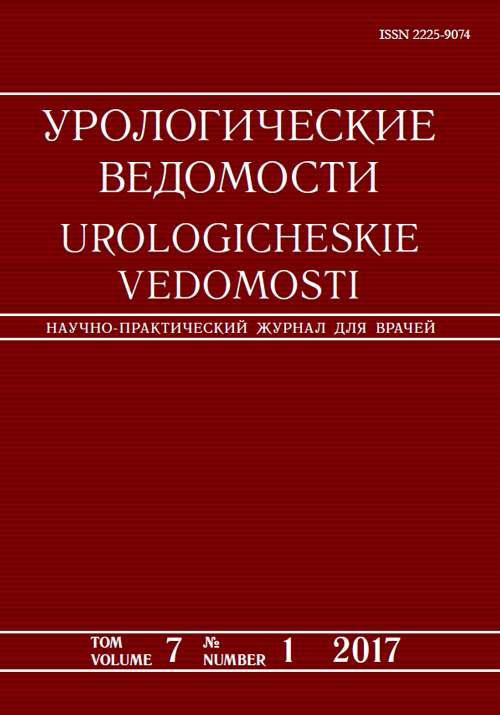卷 7, 编号 1 (2017)
- 年: 2017
- ##issue.datePublished##: 15.03.2017
- 文章: 7
- URL: https://journals.eco-vector.com/uroved/issue/view/365
- DOI: https://doi.org/10.17816/uroved71
Articles
Assessment of nutriom in treatment of urolithiasis disease
摘要
In recent years in the world has registered a steady increase of urolithiasis disease (UD). Currently it is possible to identify the causes of stone formation and reduce the number of relapsing stones by assessing the chemical composition of the stone and examining the biochemical parameters of urine and blood. It is also necessary to evaluate the stereotype of the patient’s diet among other things. One of the most effective and common methods for assessing the dietary stereotype is questionnairring. To study the interrelation between the dietary stereotype and the UD was performed by the questionnaire – Questionnaire on the assessment of the stereotype of nutrition (QASN) by Lopatkin Urology Scientific Research Institute. The questionnaire is freely available on the Internet at www.nethealth.ru in the testing section. The QASN contains questions about the daily use of a particular group of products. All food products are divided into subgroups according to trade classification. Each group includes products that are the most often sold and used on the territory of the Russian Federation. After completing the questionnaire it calculates the number of elements used per day. The norms of consumption of each substance calculates for 1 kg of body weight of the patient and calculating automatically when the patient is filling in the column “body weight”. The obtained data are compared with the average daily consumption rate of these elements in the average person. In the event of detection of abnormalities in one or several parameters it is concluded that there are significant changes in the dietary pattern.
 5-9
5-9


The use of doppler ultrasound for differential diagnosis of prostate diseases
摘要
The current study presents the results of analysis of 121 patients with suspected prostate cancer, conducted at the Urology department of the Railways hospital in the period from 2014 to 2015. The comprehensive assessment of Doppler indicators and laboratory factors in the diagnosis of prostate cancer was performed to identify their individual importance. After receiving the results of histological studies the comparative analysis of the zonal flow was carried out depending on the morphological diagnosis in the patient groups and between areas with tumor and without it. During dopplerography peak, systolic and average blood flow velocity were significantly higher in tumor areas. Using complete analysis of laboratory and instrumental parameters we achieved mathematical model allowing to increase the efficiency of differential diagnosis of prostate diseases for patients with prostate biopsy.
 10-14
10-14


Analysis of uronefrological diseases of adult population in Arkhangelsk region in 2005-2014
摘要
A comparative and dynamic analysis of the uronephrological morbidity of the adult population of the Arkhangelsk Region for 2005-2014 was conducted on the basis of the given official statistics (forms of federal statistical observation No. 12). The growth of the general and primary morbidity of the population of the Arkhangelsk Region by diseases of the genitourinary system was revealed which is connected on the one hand with the increasing in the proportion of the elderly population and more effective detection of diseases due to the new diagnostic methods, on the other hand with insufficient effectiveness of the disease prevention and screening.
 15-21
15-21


Microsurgical testicular sperm extraction (MicroTESE)in patients with non-obstructive azoospermia
摘要
Modern methods of treating infertility in men with non-obstructive azoospermia (NOA) are considered. The prognostic factors of successful sperm production by invasive manipulation on the testicles are analyzed. The aspects of hormonal preparation of patients with NOA before surgery are considered. Identification of additional hormonal factors such as follicle-stimulating hormone (FSH), inhibin B in serum and seminal plasma allows more accurately predict the outcome of microsurgical testicular sperm extraction (MicroTESE). A high level of FSH is not a contraindication for microTESE in men with NOA. Neither the FSH level nor the testicle volume are associated with the effectiveness of the operation, moreover is observed an inverse interrelation. The advantages of microsurgical technique of performing the operation and its effectiveness are considered.
 22-24
22-24


Results of surgical treatment of Peyroni’s disease
摘要
Surgical methods of treatment of Peyronie’s disease by plication corporoplasty proved to be effective in the near and distant postoperative periods in the examined group of patients. These methods made it possible to quickly achieve the normalization of the shape of the penis without affecting the erectile function which enabled for patients to restore copulative activity and improve the quality of life.
 25-29
25-29


Combined treatment of penile cancer
摘要
A clinical case of combined surgical and chemotherapeutic treatment of a patient with penile cancer is presented
 30-32
30-32


To the 110th anniversary of the first urological society in Russia
摘要
The article describes the history of the first society of urologists in Russia from the moment of its foundation to the present time.
 33-36
33-36











